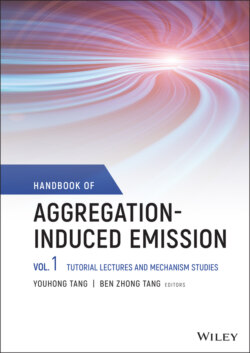Читать книгу Handbook of Aggregation-Induced Emission, Volume 1 - Группа авторов - Страница 30
2.1 Introduction
ОглавлениеTraditionally, molecular aggregation tends to reduce fluorescence efficiency because of aggregation‐caused quenching (ACQ): the formation of nonemissive excimer, intermolecular charge transfer, or energy transfer to quenching sites through strong π–π stacking, which is a large obstacle to utilize a variety of efficient luminogens in the real world [1]. The opposite phenomenon, where the compounds are non‐ or low‐emissive in dilute solution but highly emissive in the aggregated phase (aggregates in solution, film, or crystalline phase), is termed as aggregation‐induced emission (AIE) in 2001 by Tang et al., which paves an efficient way for highly efficient luminescent material design [2–4]. The compounds with AIE characteristics (AIEgens) have attracted much attention for their wide applications in solid‐state lighting, flat panel display, chemical sensor, cell imaging, and so on in the last 20 years [2]. The luminescent properties in the solid state are often significantly different from the isolated component at the molecular level. It is urgent to reveal the intrinsic AIE mechanism to realize the precise design of more efficient emitters; however, it is a challenging task.
In this rapid expanding field, many endeavors have been devoted to unravel the AIE mechanism through both theory and experimental means. The J‐aggregation was demonstrated to play an important role for the enhanced solid‐state emission of the strong conjugated rigid systems in earlier works [5]. For flexible systems, the restriction of intramolecular rotations (RIR) [6–8] was proposed firstly by comparatively analyzing the molecular steric hindrance‐, temperature‐, and viscosity‐dependent fluorescence intensities through all kinds of experimental measurements. Then, the restriction of intramolecular vibration (RIV) [3] and the restriction of intramolecular motion (RIM) [9] were put forward to explain more universal AIE mechanism through combining experiments and theoretical calculations. In theory, Peng and Shuai et al. developed a thermal vibration correlation function (TVCF) formalism [10–12] based on Fermi’s golden rule (FGR), which could quantitatively evaluate the nonradiative decay rate constants for isolated molecules, nanoaggregates, and crystals. And they proposed the AIE mechanism that the trip‐out of electron–vibration coupling and the demix of vibration modes block the excited‐state nonradiative decay channels in various rigid environments, sharply decreasing the nonradiative rate constants and turning fluorescence on [12–14]. Blancafort et al. proposed the restricted access to a conical interaction mechanism based on the potential energy surface (PES) topology analysis [15, 16] (see Chapter 9). In addition, many other scenarios have been declared, such as hydrogen‐bond‐induced excimer emission [17], vibration‐induced emission [18], the restriction of E/Z isomerization process [19], the blockage of access to dark state via isomerization mechanism [20, 21], and the reversal from dark 1(n,π*) or 1(n + σ,π*) to bright 1(π,π*) excited states for generation of the solid‐state emission [22]. In this chapter, we will focus on introducing the revealed AIE mechanism in which the photophysical behaviors are supposed to occur in the Franck–Condon region without any photoisomerizations or conical intersections in the PESs. The chapter is organized in the following manner. In the second section, we show a short overview of the theoretical methodology and procedure. In the third section, we carefully elaborate on the revealed AIE mechanism at the level of first principle by several representative AIEgens. In the fourth section, we further validate our unraveled AIE mechanism by establishing the relationship between the calculated key photophysical parameters with measurable signals in experiments. Finally, we give a brief conclusion of the currently revealed AIE mechanism and outlook of the development direction theoretically in the future.
